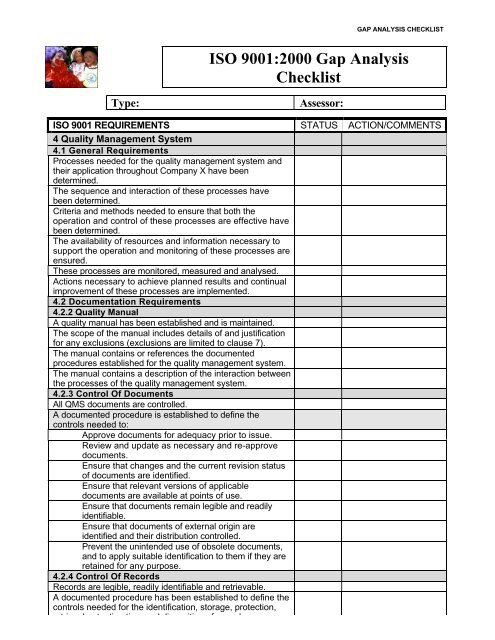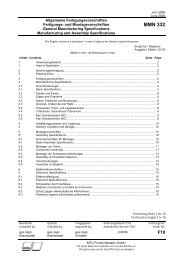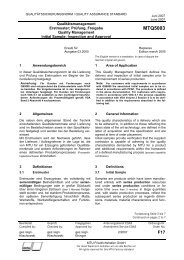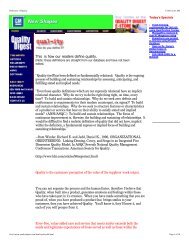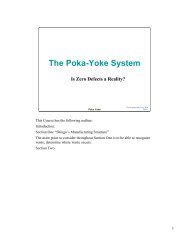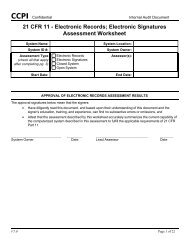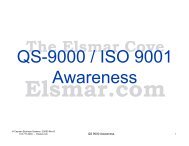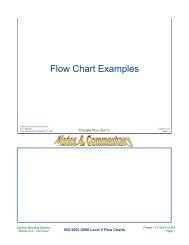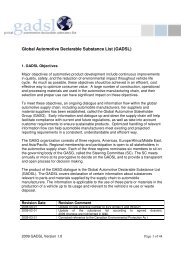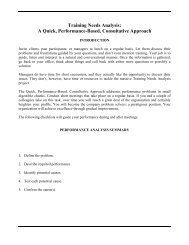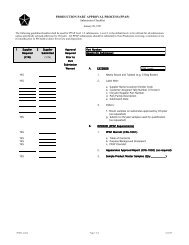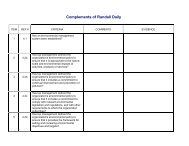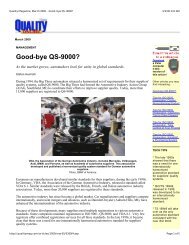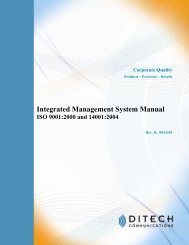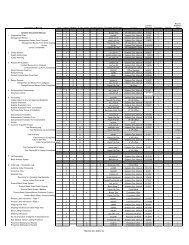ISO 9001:2000 Gap Analysis Checklist
ISO 9001:2000 Gap Analysis Checklist
ISO 9001:2000 Gap Analysis Checklist
Create successful ePaper yourself
Turn your PDF publications into a flip-book with our unique Google optimized e-Paper software.
AS/NZS <strong>ISO</strong> <strong>9001</strong>:<strong>2000</strong><br />
GAP ANALYSIS CHECKLIST<br />
<strong>ISO</strong> <strong>9001</strong>:<strong>2000</strong> <strong>Gap</strong> <strong>Analysis</strong><br />
<strong>Checklist</strong><br />
Type: Assessor:<br />
<strong>ISO</strong> <strong>9001</strong> REQUIREMENTS STATUS ACTION/COMMENTS<br />
4 Quality Management System<br />
4.1 General Requirements<br />
Processes needed for the quality management system and<br />
their application throughout Company X have been<br />
determined.<br />
The sequence and interaction of these processes have<br />
been determined.<br />
Criteria and methods needed to ensure that both the<br />
operation and control of these processes are effective have<br />
been determined.<br />
The availability of resources and information necessary to<br />
support the operation and monitoring of these processes are<br />
ensured.<br />
These processes are monitored, measured and analysed.<br />
Actions necessary to achieve planned results and continual<br />
improvement of these processes are implemented.<br />
4.2 Documentation Requirements<br />
4.2.2 Quality Manual<br />
A quality manual has been established and is maintained.<br />
The scope of the manual includes details of and justification<br />
for any exclusions (exclusions are limited to clause 7).<br />
The manual contains or references the documented<br />
procedures established for the quality management system.<br />
The manual contains a description of the interaction between<br />
the processes of the quality management system.<br />
4.2.3 Control Of Documents<br />
All QMS documents are controlled.<br />
A documented procedure is established to define the<br />
controls needed to:<br />
Approve documents for adequacy prior to issue.<br />
Review and update as necessary and re-approve<br />
documents.<br />
Ensure that changes and the current revision status<br />
of documents are identified.<br />
Ensure that relevant versions of applicable<br />
documents are available at points of use.<br />
Ensure that documents remain legible and readily<br />
identifiable.<br />
Ensure that documents of external origin are<br />
identified and their distribution controlled.<br />
Prevent the unintended use of obsolete documents,<br />
and to apply suitable identification to them if they are<br />
retained for any purpose.<br />
4.2.4 Control Of Records<br />
Records are legible, readily identifiable and retrievable.<br />
A documented procedure has been established to define the<br />
controls needed for the identification, storage, protection,<br />
retrieval, retention time and disposition of records.
5.1 Management Commitment<br />
Top management has communicated the importance of<br />
meeting customer, statutory and regulatory requirements.<br />
Quality policy is established.<br />
Quality objectives are established.<br />
5.2 Customer Focus<br />
Top management shall ensure that customer requirements<br />
are determined and are met with the aim of enhancing<br />
customer satisfaction (see 7.2.1 and 8.2.1).<br />
5.3 Quality Policy<br />
Policy is appropriate to the purpose of Company X.<br />
Policy includes a commitment to comply with requirements<br />
and continually improve the effectiveness of the QMS.<br />
Policy provides a framework for establishing and reviewing<br />
quality objectives.<br />
Policy is communicated and understood.<br />
Policy is reviewed for continuing suitability.<br />
5.4 Planning<br />
5.4.1 Quality Objectives<br />
Quality objectives, including those needed to meet<br />
requirements for product, are established at relevant<br />
functions and levels within Company X.<br />
The quality objectives are measurable and consistent with<br />
the quality policy.<br />
5.4.2 Quality Management System Planning<br />
QMS planning is carried out in order to meet the requirements<br />
given in 4.1, as well as the quality objectives.<br />
The integrity of the QMS is maintained when changes to the<br />
QMS are planned and implemented.<br />
5.5 Responsibility, Authority And Communication<br />
5.5.1 Responsibility And Authority<br />
Responsibilities and authorities are defined and<br />
communicated.<br />
5.5.2 Management Representative<br />
The Quality Systems Manager reports to top management on<br />
the performance of the QMS and any need for improvement.<br />
The Quality Systems Manager ensures the promotion of<br />
awareness of customer requirements throughout Company<br />
X.<br />
5.5.3 Internal Communication<br />
Appropriate communication processes are established.<br />
Communication takes place regarding the effectiveness of<br />
the QMS.<br />
5.6 Management Review<br />
5.6.1 General<br />
Top management reviews the QMS at planned intervals, to<br />
ensure its continuing suitability, adequacy & effectiveness.<br />
The review includes assessing opportunities for<br />
improvement and the need for changes to the QMS, including<br />
the quality policy and quality objectives.<br />
Records from management reviews are maintained.<br />
5.6.2 Review Input<br />
Includes results of audits.<br />
Includes customer feedback.<br />
Includes process performance and product conformity.<br />
Includes status of preventive and corrective actions.<br />
AS/NZS <strong>ISO</strong> <strong>9001</strong>:<strong>2000</strong><br />
GAP ANALYSIS CHECKLIST
eviews.<br />
Includes changes that could affect the QMS.<br />
Includes recommendations for improvement.<br />
5.6.3 Review Output<br />
Includes improvement of the effectiveness of the QMS and<br />
its processes.<br />
Includes improvement of product related to customer<br />
requirements.<br />
Includes resource needs.<br />
6 Resource Management<br />
6.1 Provision Of Resources<br />
Company X determines and provides the resources needed<br />
to implement and maintain the QMS and continually improve<br />
its effectiveness.<br />
Company X determines and provides the resources needed<br />
to enhance customer satisfaction by meeting customer<br />
requirements.<br />
6.2 Human Resources<br />
6.2.1 General<br />
Personnel performing work affecting product quality are<br />
competent on the basis of appropriate education, training,<br />
skills and experience.<br />
6.2.2 Competence, Awareness And Training<br />
The necessary competence of personnel to perform work<br />
affecting product quality has been determined.<br />
Training has been provided or other actions taken to satisfy<br />
these competency/awareness/training needs.<br />
The effectiveness of the actions taken has been evaluated.<br />
Personnel are aware of the relevance and importance of<br />
their activities and how they contribute to the achievement of<br />
the quality objectives.<br />
Records of education, training, skills and experience are<br />
maintained.<br />
6.3 Infrastructure<br />
Company X has determined, provided and maintained the<br />
infrastructure needed to achieve conformity to product<br />
requirements. (This includes, as applicable, buildings,<br />
workspace, utilities, process equipment and supporting<br />
services)<br />
6.4 Work Environment<br />
Company X has determined and manages the work<br />
environment to achieve conformity to product requirements.<br />
7 Product Realization<br />
7.1 Planning Of Product Realization<br />
Company X has planned and developed the processes<br />
needed for product realization. Planning of product<br />
realization is consistent with the requirements of the other<br />
processes of the QMS.<br />
In planning product realization, the organization shall<br />
determine the following, as appropriate:<br />
Quality objectives and requirements for the product.<br />
The need to establish processes, documents, and<br />
provide resources specific to the product.<br />
Required verification, validation, monitoring,<br />
inspection and test activities specific to the product<br />
and the criteria for product acceptance.<br />
AS/NZS <strong>ISO</strong> <strong>9001</strong>:<strong>2000</strong><br />
GAP ANALYSIS CHECKLIST
Records needed to provide evidence that the<br />
realization processes and resulting product meet<br />
requirements.<br />
The output of this planning is in a form suitable for Company<br />
X's method of operations.<br />
7.2 Customer-Related Processes<br />
7.2.1 Determination Of Requirements Related To The<br />
Product<br />
The requirements specified by the customer, including the<br />
requirements for delivery and post-delivery activities are<br />
determined.<br />
The requirements not stated by the customer but necessary<br />
for specified or intended use, where known, are determined.<br />
The statutory and regulatory requirements related to the<br />
product are determined.<br />
Additional requirements determined by the organization are<br />
determined.<br />
7.2.2 Review Of Requirements Related To The<br />
Product<br />
Company X reviews the requirements related to the product.<br />
This review is conducted prior to Company X’s commitment<br />
to supply a product to the customer (e.g. submission of<br />
tenders, acceptance of contracts or orders, acceptance of<br />
changes to contracts or orders).<br />
The review ensures that:<br />
Product requirements are defined.<br />
Contract or order requirements differing from those<br />
previously expressed are resolved.<br />
The organization has the ability to meet the defined<br />
requirements.<br />
Records of the results of the review and actions arising<br />
from the review are maintained.<br />
Where the customer provides no documented statement of<br />
requirement, the customer requirements are confirmed by<br />
Company X before acceptance.<br />
Where product requirements are changed, Company X<br />
ensures that relevant documents are amended and that<br />
relevant personnel are made aware of the changed<br />
requirements.<br />
7.2.3 Customer Communication<br />
Company X has determined and implemented effective<br />
arrangements for communicating with customers in relation<br />
to:<br />
Product information.<br />
Enquiries, contracts or order handling, including<br />
amendments.<br />
Customer feedback, including customer complaints.<br />
7.3 Design And Development<br />
7.3.1 Design And Development Planning<br />
Company X plans and controls the design and development<br />
of product.<br />
During the design and development planning, Company X<br />
determines the:<br />
Design and development stages.<br />
Review, verification and validation that are<br />
appropriate to each design and development stage.<br />
Responsibilities and authorities for design and<br />
AS/NZS <strong>ISO</strong> <strong>9001</strong>:<strong>2000</strong><br />
GAP ANALYSIS CHECKLIST
Company X manages the interfaces between different<br />
groups involved in design and development to ensure<br />
effective communication and clear assignment of<br />
responsibility.<br />
Planning output is updated, as appropriate, as the design and<br />
development progresses.<br />
7.3.2 Design And Development Inputs<br />
Inputs relating to product requirements are determined and<br />
records maintained.<br />
Product requirement inputs include:<br />
Functional and performance requirements.<br />
Applicable statutory and regulatory requirements.<br />
Where applicable, information derived from previous<br />
similar designs.<br />
Other requirements essential for design and<br />
development.<br />
These inputs are reviewed for adequacy. Requirements are<br />
complete, unambiguous and not in conflict with each other.<br />
7.3.3 Design And Development Outputs<br />
The outputs of design and development are provided in a<br />
form that enables verification against the design and<br />
development input and shall be approved prior to release.<br />
Design and development outputs:<br />
Meet the input requirements for design and<br />
development.<br />
Provide appropriate information for purchasing,<br />
production and for service provision.<br />
Contain or reference product acceptance criteria.<br />
Specify the characteristics of the product that are<br />
essential for its safe and proper use.<br />
7.3.4 Design And Development Review<br />
At suitable stages, systematic reviews of design and<br />
development are performed in accordance with planned<br />
arrangements to:<br />
Evaluate the ability of the results of design and<br />
development to meet requirements.<br />
Identify any problems and propose necessary<br />
actions.<br />
Participants in such reviews include representatives of<br />
functions concerned with the design and development<br />
stage(s) being reviewed.<br />
Records of the results of the reviews and any necessary<br />
actions are maintained.<br />
7.3.5 Design And Development Verification<br />
Verification is performed in accordance with planned<br />
arrangements to ensure that the design and development<br />
outputs met the design and development input requirements.<br />
Records of the results of the verification and any necessary<br />
actions are maintained.<br />
7.3.6 Design And Development Validation<br />
Design and development validation is performed in<br />
accordance with planned arrangements so that the resulting<br />
product is capable of meeting the requirements for the<br />
specified application or intended use, where known.<br />
Wherever practicable, validation is completed prior to the<br />
delivery or implementation of the product.<br />
Records of the results of validation and any necessary<br />
AS/NZS <strong>ISO</strong> <strong>9001</strong>:<strong>2000</strong><br />
GAP ANALYSIS CHECKLIST
7.3.7 Control Of Design And Development Changes<br />
Design and development changes are identified and records<br />
maintained.<br />
The changes are reviewed, verified and validated, as<br />
appropriate, and approved before implementation.<br />
The review of design and development changes is included<br />
in evaluation of the effect of the changes on constituent<br />
parts and product already delivered.<br />
Records of the results of the review of changes and any<br />
necessary actions are maintained.<br />
7.4 Purchasing<br />
7.4.1 Purchasing Process<br />
Company X ensures that purchased product conforms to<br />
specified purchase requirements.<br />
The type and extent of control applied to the supplier and the<br />
purchased product is dependent upon the effect of the<br />
purchased product on subsequent product realization or the<br />
final product.<br />
Company X evaluates and selects suppliers based on their<br />
ability to supply product in accordance with Company X’s<br />
requirements.<br />
Criteria for the selection, evaluation and re-evaluation of<br />
suppliers are established.<br />
Records of the results of evaluations and any necessary<br />
actions arising from the evaluation are maintained.<br />
7.4.2 Purchasing Information<br />
Purchasing information describes the product to be<br />
purchased.<br />
Where appropriate, purchasing information includes:<br />
Requirements for approval of product, procedures,<br />
processes and equipment.<br />
Requirements for qualification of personnel.<br />
Quality management system requirements.<br />
Company X ensures the adequacy of specified purchase<br />
requirements prior to their communication to the supplier.<br />
7.4.3 Verification Of Purchased Product<br />
Company X has established and implemented the inspection,<br />
or other activities, necessary for ensuring that purchased<br />
product meets specified purchase requirements.<br />
Where Company X or its customer intends to perform<br />
verification at the supplier's premises, Company X states the<br />
intended verification arrangements and method of product<br />
release in the purchasing information.<br />
7.5 Production And Service Provision<br />
7.5.1 Control Of Production And Service Provision<br />
Company X plans and carries out production and service<br />
provision under controlled conditions.<br />
Controlled conditions include, as applicable, the:<br />
Availability of information that describes the<br />
characteristics of the product.<br />
Availability of work instructions, as necessary.<br />
Use of suitable equipment.<br />
Availability and use of monitoring and measuring<br />
devices.<br />
Implementation of monitoring and measurement.<br />
Implementation of release, delivery and post-delivery<br />
AS/NZS <strong>ISO</strong> <strong>9001</strong>:<strong>2000</strong><br />
GAP ANALYSIS CHECKLIST
7.5.2 Validation Of Processes For Production And<br />
Service Provision<br />
Company X validates any processes for production and<br />
service provision where the resulting output cannot be<br />
verified by subsequent monitoring or measurement. (This<br />
includes any processes where deficiencies become<br />
apparent only after the product is in use or the service has<br />
been delivered)<br />
Validation demonstrates the ability of these processes to<br />
achieve planned results.<br />
The organization has established arrangements for these<br />
processes including, as applicable:<br />
Defined criteria for review & approval of the<br />
processes.<br />
Approval of equipment & qualification of personnel.<br />
Use of specific methods and procedures.<br />
Requirements for records.<br />
Revalidation.<br />
7.5.3 Identification And Traceability (In some industry<br />
sectors, configuration management is a means by which<br />
identification and traceability are maintained)<br />
Where appropriate, Company X has identified the product by<br />
suitable means throughout product realization.<br />
Company X identifies the product status with respect to<br />
monitoring and measurement requirements.<br />
Where traceability is a requirement, Company X controls and<br />
records the unique identification of the product.<br />
7.5.4 Customer Property (can include intellectual<br />
property)<br />
Company X exercises care with customer property while it<br />
is under Company X’s control or being used by Company X.<br />
Company X identifies, verifies, protects and safeguards<br />
customer property provided for use or incorporation into the<br />
product.<br />
If any customer property is lost, damaged or otherwise<br />
found to be unsuitable for use, this is reported to the<br />
customer and records maintained.<br />
7.5.5 Preservation Of Product<br />
Company X preserves the conformity of product during<br />
internal processing and delivery to the intended destination.<br />
This preservation includes identification, handling, packaging,<br />
storage and protection.<br />
Preservation also applies to the constituent parts of a<br />
product.<br />
7.6 Control Of Monitoring And Measuring Devices<br />
Company X determines the monitoring and measurement to<br />
be undertaken and the monitoring and measuring devices<br />
needed to provide evidence of conformity of product to<br />
determined requirements.<br />
Company X has established processes to ensure that<br />
monitoring and measurement can be carried out and are<br />
carried out in a manner that is consistent with the monitoring<br />
and measurement requirements.<br />
Where necessary to ensure valid results, measuring<br />
equipment is:<br />
Calibrated or verified at specified intervals, or prior to<br />
use, against measurement standards traceable to<br />
AS/NZS <strong>ISO</strong> <strong>9001</strong>:<strong>2000</strong><br />
GAP ANALYSIS CHECKLIST
where no such standards exist, the basis used for<br />
calibration or verification is recorded.<br />
Adjusted or re-adjusted as necessary.<br />
Identified to enable the calibration status to be<br />
determined.<br />
Safeguarded from adjustments that would invalidate<br />
the measurement result.<br />
Protected from damage and deterioration during<br />
handling, maintenance and storage.<br />
Company X assesses and records the validity of the<br />
previous measuring results when the equipment is found not<br />
to conform to requirements.<br />
Company X takes appropriate action on the equipment and<br />
any product affected.<br />
Records of the results of calibration and verification are<br />
maintained.<br />
When used in the monitoring and measurement of specified<br />
requirements, the ability of computer software to satisfy the<br />
intended application is confirmed. This is undertaken prior to<br />
initial use and reconfirmed as necessary.<br />
8 Measurement, <strong>Analysis</strong> And Improvement<br />
8.1 General<br />
Company X plans and implements the monitoring,<br />
measurement, analysis and improvement processes needed<br />
to:<br />
Demonstrate conformity of the product.<br />
Ensure conformity of the quality management system.<br />
Continually improve the effectiveness of the quality<br />
management system.<br />
This includes determination of applicable methods, including<br />
statistical techniques, and the extent of their use.<br />
8.2 Monitoring And Measurement<br />
8.2.1 Customer Satisfaction<br />
As one of the measurements of the performance of the<br />
QMS, Company X monitors information relating to customer<br />
perception as to whether Company X has met customer<br />
requirements.<br />
The methods for obtaining and using this information has<br />
been determined.<br />
8.2.2 Internal Audit<br />
Internal audits are conducted at planned intervals.<br />
Internal audits determine whether the QMS:<br />
Conforms to the planned arrangements (see 7.1), to<br />
the requirements of <strong>ISO</strong> <strong>9001</strong> and to the QMS<br />
requirements established by Company X.<br />
Is effectively implemented and maintained.<br />
The audit programme is planned, taking into consideration the<br />
status and importance of the processes and areas to be<br />
audited, as well as the results of previous audits.<br />
The audit criteria, scope, frequency & methods are defined.<br />
Selection of auditors and conduct of audits ensure<br />
objectivity and impartiality of the audit process.<br />
Auditors do not audit their own work.<br />
The responsibilities and requirements for planning and<br />
conducting audits, and for reporting results and maintaining<br />
records are defined in a documented procedure.<br />
AS/NZS <strong>ISO</strong> <strong>9001</strong>:<strong>2000</strong><br />
GAP ANALYSIS CHECKLIST
ensure that actions are taken without undue delay to<br />
eliminate detected nonconformities and their causes.<br />
Follow-up activities include the verification of the actions<br />
taken and the reporting of verification results.<br />
8.2.3 Monitoring And Measurement Of Processes<br />
Company X applies suitable methods for monitoring and,<br />
where applicable, measurement of the QMS processes.<br />
These methods demonstrate the ability of the processes to<br />
achieve planned results.<br />
When planned results are not achieved, correction and<br />
corrective action are taken, as appropriate, to ensure<br />
conformity of the product.<br />
8.2.4 Monitoring And Measurement Of Product<br />
Company X monitors and measures the characteristics of<br />
the product to verify that product requirements have been<br />
met.<br />
This is carried out at appropriate stages of the product<br />
realization process in accordance with the planned<br />
arrangements.<br />
Evidence of conformity with the acceptance criteria is<br />
maintained.<br />
Records indicate the person(s) authorizing release of<br />
product.<br />
Product release and service delivery do not proceed until the<br />
planned arrangements (see 7.1) have been satisfactorily<br />
completed, unless otherwise approved by a relevant<br />
authority and, where applicable, by the customer.<br />
8.3 Control Of Nonconforming Product<br />
Company X ensures that product which does not conform to<br />
product requirements is identified and controlled to prevent<br />
its unintended use or delivery.<br />
The controls and related responsibilities and authorities for<br />
dealing with nonconforming product are defined in a<br />
documented procedure.<br />
Company X deals with nonconforming product by one or<br />
more of the following ways:<br />
By taking action to eliminate the detected<br />
nonconformity.<br />
By authorizing its use, release or acceptance under<br />
concession by a relevant authority and, where<br />
applicable, by the customer.<br />
By taking action to preclude its original intended use<br />
or application.<br />
Records of the nature of nonconformities and any<br />
subsequent actions taken, including concessions obtained,<br />
are maintained.<br />
When nonconforming product is corrected it is subject to reverification<br />
to demonstrate conformity to the requirements.<br />
When nonconforming product is detected after delivery or use<br />
has started, the organization takes action appropriate to the<br />
effects, or potential effects, of the nonconformity.<br />
8.4 <strong>Analysis</strong> Of Data<br />
Company X has determined, collected and analysed<br />
appropriate data to demonstrate the suitability and<br />
effectiveness of the QMS and has evaluated where continual<br />
improvement of the effectiveness of the QMS can be made.<br />
(This includes data generated as a result of monitoring and<br />
measurement and from other relevant sources)<br />
AS/NZS <strong>ISO</strong> <strong>9001</strong>:<strong>2000</strong><br />
GAP ANALYSIS CHECKLIST
Customer satisfaction (see 8.2.1).<br />
Conformity to product requirements (see 7.2.1).<br />
Characteristics and trends of processes and products<br />
including opportunities for preventive action.<br />
Suppliers.<br />
8.5 Improvement<br />
8.5.1 Continual Improvement<br />
Company X continually improves the effectiveness of the<br />
quality management system through the use of the quality<br />
policy, quality objectives, audit results, analysis of data,<br />
corrective and preventive actions and management review.<br />
8.5.2 Corrective Action<br />
Company X takes action to eliminate the cause of<br />
nonconformities in order to prevent recurrence.<br />
Corrective actions are appropriate to the effects of the<br />
nonconformities encountered.<br />
A documented procedure is established to define requirements<br />
for:<br />
Reviewing nonconformities (including customer<br />
complaints).<br />
Determining the causes of nonconformities.<br />
Evaluating the need for action to ensure that<br />
nonconformities do not recur.<br />
Determining and implementing action needed.<br />
Records of the results of action taken.<br />
Reviewing corrective action taken.<br />
8.5.3 Preventive Action<br />
Company X determines action to eliminate the causes of<br />
potential nonconformities in order to prevent their occurrence.<br />
Preventive actions are appropriate to the effects of the<br />
potential problems.<br />
A documented procedure is established to define requirements<br />
for:<br />
Determining potential nonconformities and their causes.<br />
Evaluating the need for action to prevent occurrence of<br />
nonconformities.<br />
Determining and implementing action needed.<br />
Records of results of action taken (see 4.2.4).<br />
Reviewing preventive action taken.<br />
AS/NZS <strong>ISO</strong> <strong>9001</strong>:<strong>2000</strong><br />
GAP ANALYSIS CHECKLIST


